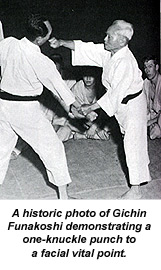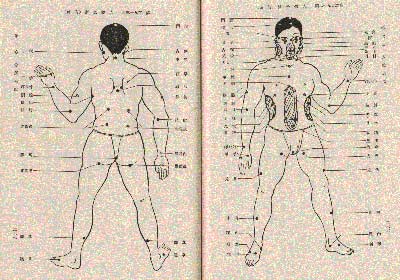The Case For Vital Points
By Rick Clark
People join the martial arts for many reasons, and learning self-defense
is one of the most important. But, is that what people are getting?
 With
the development of martial arts, both as a sport and a martial way,
there appears to be a decrease in the combative applications found in
the arts. Emphasis seems to be placed on safety, protective equipment,
rules of competition, limiting striking areas, physical conditioning,
personal development, or sport applications of technique. And competitions
divide contestants into divisions by age, sex, rank and weight.
With
the development of martial arts, both as a sport and a martial way,
there appears to be a decrease in the combative applications found in
the arts. Emphasis seems to be placed on safety, protective equipment,
rules of competition, limiting striking areas, physical conditioning,
personal development, or sport applications of technique. And competitions
divide contestants into divisions by age, sex, rank and weight.
While it is still possible to teach and learn self-defense techniques
from martial arts that have a sports or spiritual focus, more often
than not effective street self-defense has been lost somewhere in the
process. In addition, competitive divisions often isolate the student
from facing opponents that are much larger, heavier or stronger.
Artificial divisions will not occur in real life. If a woman is assaulted,
it will probably be done by a male who is taller, stronger, and heavier.
If a child is abducted, it will be by an adult. In most situations,
the attacker will attempt to have the advantage. Our job as martial
arts instructors is to provide a tool for the smaller, younger, or weaker
individual to use when faced with a determined attacker.
What will give the smaller person an advantage over the larger and stronger
opponent? If you look at judo tournaments, you will see that the larger
opponent has an advantage over the smaller judoka. Of course, the smaller
judoka can throw and score on the larger opponent, but it requires a
high degree of skill and ability to do so. This is one of the reasons
you see weight divisions in judo tournaments. Weight does have an impact.
Skill level is another consideration in tournaments. You do not see
black belts sparring against yellow or green belts. Can the lower ranks
score points on a higher-ranked and experienced martial artist? Of course
they can, but by and large the black belts should be able to beat the
lower-ranked students. Do you see juniors competing against adults?
Do you see senior students competing against juniors or younger adults?
No, is it because the junior or senior could not win? Of course not,
they could, but in the interest of being fair to the competitors, age
divisions are set up to lay down a level playing field for them.
Therefore, we must train our students to defend themselves against older
(or younger), stronger, bigger, faster, or more skilled opponents. It
is imperative that we offer a way to equalize the advantages the aggressor
may possess against our students. Everyone knows there are places on
the human body that are vulnerable to attack. It is common knowledge
that a punch to the stomach can cause a person to lose their breath.
Yet, with training, you can learn to take a strong punch to the stomach.
If delivered to the testicles, throat, or eyes, that same punch could
be quite destructive.
So at one level, we understand there are targets on the human body that
are more vulnerable than others. If we understand and accept that there
are places on the body that are more susceptible, then it would seem
logical we should look for these weaker places. Once we know where these
weak points are located, it then becomes a matter of developing the
skill to make use of these points under stress.
For centuries, Sunzi's The Art of War has been one of the treasured
books of the literate warriors of the Orient. Even today, in the West,
we can find words of sound advice. For example, Sunzi said, "to
be certain to take what you attack is to attack a place the enemy does
not protect." You might stop and ask, "how does that affect
my practice of self-defense?"
To answer this, I would like to lay a little foundation. If you look
in chapter six of Funakoshi Gichin's Karate-Do Kyohan, you will find
a discussion of vital points (kyusho) and the results of strikes to
various parts of the body.

In many cases, the places he describes to strike are quite obvious
targets to attack. For example, some of the targets are ones that the
man on the street would be aware of attacking. These are the eyes, nose,
groin, and solar plexus. Yet, in this same section, he states that if
you strike a specific point on the wrist, you will knock out your opponent.
Funakoshi also details points on the arm, legs, back, chest, neck, and
head that will cause an opponent to become unconscious or possibly fatal
if struck.
It is not only Funakoshi or other Oriental authors that make such claims.
In his Modern Judo series (1942), Charles Yerkow notes a number of points
that would be used in self-defense, but not in practice, as they are
very dangerous. For instance, he notes one point at the bottom of the
foot that can be deadly when struck. You can find examples of places
to strike in Professor H.H. Hunter's Super Ju-Jitsu (1938), in which
he locates points on the arm and leg that will create "partial
paralysis" if struck.
I would like to go back to the Sunzi quote, "to be certain to take
what you attack is to attack a place the enemy does not protect."
If we look at the comments of Hunter, Yerkow, and Funakoshi, they all
state there are places on the extremities that can be struck to cause
partial paralysis, unconsciousness, or even death. If a person is being
attacked, what does the individual have to do to make contact with you?
They must put out their arm or leg to attack. Once they place a part
of their body near you, they are in effect giving you a target to attack.
I am confident that individuals would not be overly concerned with a
person attacking the arm or leg. Yet, they would be protective of their
eyes, noes, ears, throat, groin, or solar plexus.
So, if you are aware of the results of attacking vital points on your
opponent's arms and legs, it is possible to have a relatively clear
shot at those targets. Once you have successfully struck these points,
it will be too late for your opponent to adequately defend against further
attacks to vital points. The normally harder to access points may now
be seen as targets of opportunity and readily attacked.
A sound knowledge of the vital points located on the body's extremities
can prove to be a valuable asset in any self-defense situation. This
understanding offers you the door to enter should you wish to attack
points on the head, neck, chest, or back, providing an equalizer for
the serious student of self-defense.
About The Author:
Rick Clark specializes in the study of vital point applications within
traditional martial art techniques and teaches vital points seminars
throughout the world. He has published numerous articles and books
on the subject and has just published "Pressure Point Fighting:
A guide To The Secret Heart Of Asian Martial Arts," published
by Tuttle. He can be contacted at 3099 E. Dallas Rd., Terre Haute
IN, 47802, or via e-mail at is rick.aodenkou@worldnet.att.net.
Editor's Note: This article
is an edited rendition of one that was to appear in volume Bugeisha
magazine, but the issue unfortunately never went to print. It is reprinted
her with permission of Bugeisha and its Editor, Angle Lemus.